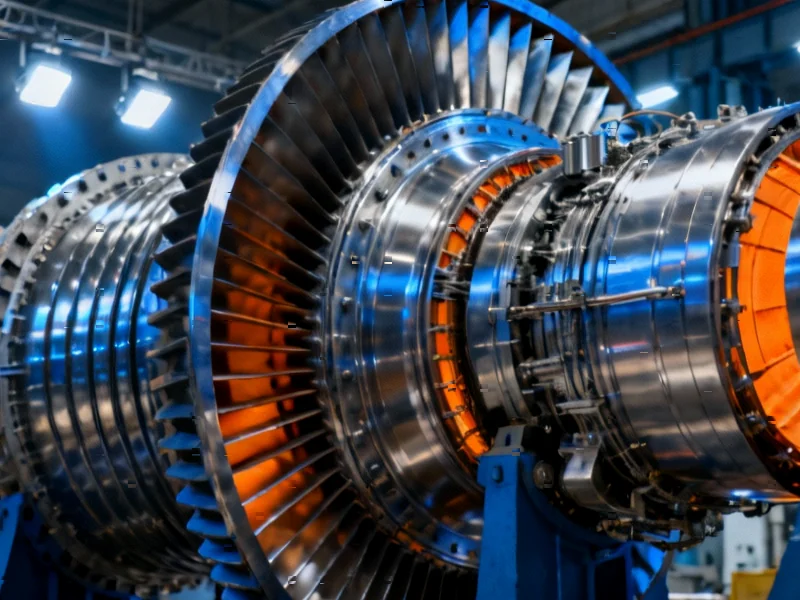The Unexpected Revival of Gas Turbine Manufacturing
In a dramatic reversal of fortune, gas turbine manufacturers are experiencing an unprecedented surge in demand driven by artificial intelligence’s insatiable appetite for electricity. Just three years ago, industry leaders were declaring gas turbines obsolete, with Siemens announcing massive job cuts and predicting permanent market shrinkage. Today, factories like Mitsubishi Heavy Industries’ Takasago plant are operating at maximum capacity, struggling to meet orders that have increased by nearly 50% compared to the previous five-year average.
Table of Contents
The shift has been so rapid that manufacturers who were scaling down operations are now racing to double production within two years. According to energy consultancy Dora Partners, orders are forecast to reach 1,025 units this year, with 183 being large units—the highest number since 2011. This represents a stunning turnaround for an industry that seemed destined for decline in the face of renewable energy expansion and global decarbonization commitments.
AI Data Centers: The Driving Force Behind the Boom
The primary catalyst for this resurgence comes from an unexpected source: the massive computing requirements of artificial intelligence systems. Data centers powering AI applications need reliable, continuous electricity that renewables alone cannot yet provide consistently. The U.S. Department of Energy forecasts that data centers will consume 6.7 to 12% of U.S. electricity by 2028, up from just 4.4% in 2023.
“There’s real demand from data centers and AI. That’s decisively different from previous cycles,” says Takao Tsukui, president of Mitsubishi Power. “If somebody is going to tell me AI is going to stop and nobody is going to use it, then I’d think this would be a risk but I don’t think that’s going to happen.”
This demand has transformed the United States into the global epicenter of new gas-fired power plant construction. Major projects like Meta’s Hyperion data center campus in Louisiana are driving utilities such as Entergy to build multiple new gas plants specifically to power AI infrastructure., as earlier coverage
The Global Supply Crunch and Its Consequences
The concentrated demand from U.S. tech companies has created a severe supply bottleneck that is reverberating across global energy markets. The oligopoly of Mitsubishi Heavy Industries, Siemens, and GE Vernova that controls approximately two-thirds of global gas turbine supply cannot scale production quickly enough to meet the surge.
Customers now face waiting periods of three to five years for new turbines, with manufacturers reportedly demanding deposits to reserve production slots—a practice last seen during the early 2000s boom. GE Vernova has indicated it’s largely sold out for 2026 and 2027 and is already negotiating deliveries for 2030., according to recent developments
The supply constraints have particularly severe implications for emerging economies in Asia, where natural gas was expected to serve as a “bridge fuel” between coal and renewables. Countries like Vietnam and the Philippines that have invested heavily in LNG infrastructure now face potential project cancellations or delays due to turbine unavailability., according to related coverage
Environmental and Geopolitical Fallout
Climate activists have expressed alarm at the gas turbine renaissance, noting that it contradicts the Paris Agreement’s goals to limit global warming. While manufacturers are developing turbines capable of burning hydrogen for zero-emission power, the availability of clean hydrogen at scale remains uncertain.
The situation also carries significant geopolitical implications. With China still years away from mastering large gas turbine technology, the U.S. and Japan previously held influential positions as suppliers to developing nations. As turbines become increasingly allocated to U.S. AI projects, this diplomatic leverage diminishes.
“Nobody foresaw the US coming in like this for the turbines,” says Raghav Mathur, a gas analyst at Wood Mackenzie. “Even if Asian utilities want to place an order, they have to wait four or five years, which means they are stranded for the next four or five years.”
Market Dynamics and Long-term Outlook
The current boom differs fundamentally from previous cycles in both driver and potential duration. Unlike the early 2000s surge driven by U.S. power sector deregulation, today’s demand stems from tangible AI infrastructure requirements that show no signs of abating.
Industry executives predict high demand will persist for five to ten years “at least,” with Mitsubishi Power reporting that annual orders have jumped from 40 gigawatts between 2021-2023 to 60-70 GW between 2024-2026. The Middle East is also contributing to demand as the region seeks to use domestic gas resources for power generation and export compression.
However, concerns about an AI bubble are creating market jitters. Some experts question whether the current spending spree on AI infrastructure is sustainable, particularly given efficiency improvements that could reduce computing power requirements over time.
The Ripple Effects on Global Energy Transition
The turbine supply crunch threatens to derail carefully laid energy transition plans across emerging economies. With gas-fired power plants delayed or canceled due to equipment shortages, many countries may turn to coal plants—often using Chinese technology—as their only viable option for meeting immediate electricity needs.
This creates a paradoxical situation where the AI revolution in developed nations could inadvertently increase coal dependence in developing regions, potentially offsetting carbon reduction achievements elsewhere. The International Energy Agency predicts data centers’ global electricity use will double by 2030 to 945 terawatt hours—more than Japan’s current consumption—suggesting the pressure on energy systems will only intensify.
As manufacturers focus on meeting U.S. AI demand, the very markets that were expected to drive future LNG growth—Southeast Asia, South Asia, and Latin America—find themselves sidelined in the global race for gas turbines, creating new challenges for global energy equity and climate goals.
Related Articles You May Find Interesting
- The Industrial Impact of AI’s Adult Frontier: Beyond the Obvious Concerns
- Microsoft Confirms Widespread Authentication Failures in Latest Windows Releases
- UK Tax Reform Targets Online Retail Giants in Budget Shakeup
- Tech Titans and Royals Unite in Unprecedented Call to Pause AI Superintelligence
- YouTube Deploys AI Likeness Detection to Combat Unauthorized Deepfakes of Top Cr
This article aggregates information from publicly available sources. All trademarks and copyrights belong to their respective owners.
Note: Featured image is for illustrative purposes only and does not represent any specific product, service, or entity mentioned in this article.



